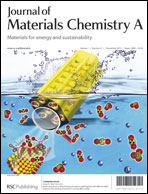Microporous organic polymers incorporating dicarboximide units for H2 storage and remarkable CO2 capture†
Abstract
Anthracene-based microporous polymers comprised of different dicarboximide units (AMPs) are synthesized efficiently by the dioxane forming reactions. AMPs display a BET surface area in the range of 800–1241 m2 g−1, and reversibly adsorb 1.90 wt% H2 at 1.13 bar/77 K with an isosteric heat of adsorption of 7.4 kJ mol−1. The CO2 adsorption studies showed an enhanced affinity with a notable uptake capacity reaching more than 4.2 mmol g−1 at 273 K/1 bar combined with a very high isosteric heat value of adsorption (32 kJ mol−1). CO2 adsorption capacity at high pressure is also evaluated reaching up to 15.61 mmol g−1 at 295 K/40 bar for AMP-3. The hydrogen adsorption and impressive CO2 capture of these materials are attributed to the high concentration of sub-nanometre micropores, as verified by Horvath–Kawazoe (HK) and NLDFT analyses of low-pressure nitrogen adsorption data as well as the benefit of the accessible areas decorated with the imide functionalities within the scaffold of the network polymer. The aforementioned promising results suggest that the incorporation of bismaleimide functional units into the rigid framework structure can improve the performance of AMPs like polymers in gas adsorption applications due to their storage related porous properties.


 Please wait while we load your content...
Please wait while we load your content...